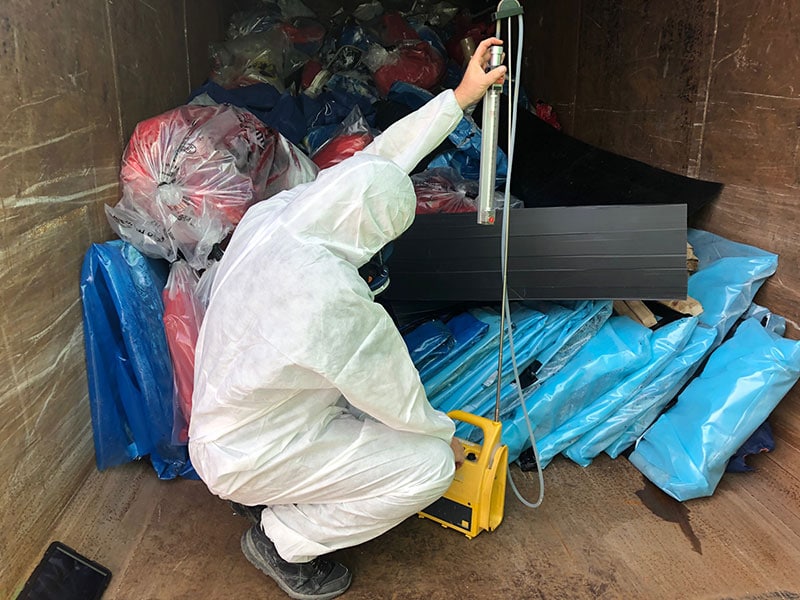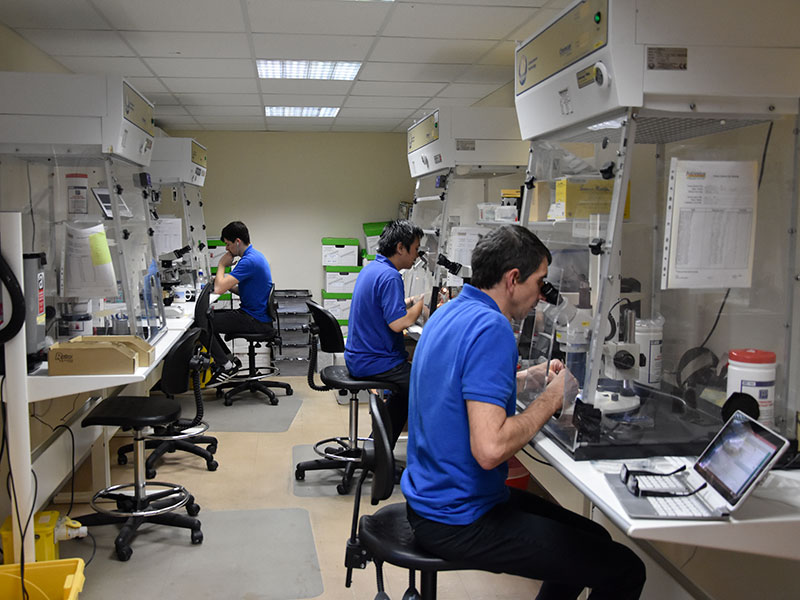How do you check the quality of asbestos air testing and monitoring?
After all, in the absence of such controls, there can be great variances in the results that asbestos air testing and the subsequent analysis produces, including across different analysts and laboratories.
Such variation could undermine the confidence that an employer has in those results when attempting to determine the concentration of airborne asbestos fibres in a particular location. It could also make a difference to the exact decisions that the employer takes to help manage asbestos risks, perhaps bringing health and safety risks and legal issues.
So, if you are looking to arrange asbestos air monitoring and testing in any of a broad range of circumstances, you might be interested in knowing how you can most effectively check the quality of such testing. Below, we have sought to address this question.
Importance of quality assurance in asbestos air testing
As an employer, you might be largely compelled to arrange asbestos air testing at a particular site because of the legal requirement to do so. Regulation 19 of the Control of Asbestos Regulations 2012, or CAR 2012 – which is the overarching asbestos legislation for non-domestic premises in Great Britain – stipulates that employers must arrange the regular monitoring of airborne asbestos fibres, in addition to keeping records of the results.
Furthermore, Regulation 20 of CAR 2012 requires employers to ensure any person they engage to carry out asbestos air testing and site clearance is competent and accredited by the appropriate accreditation body.
If an employer will be carrying out their own air testing, they will need to do it in a way that satisfies the criteria set out in ISO 17025 (a standard that enables laboratories to demonstrate they are competent in their operations and produce valid results).
Poor-quality asbestos air testing can also lead to potentially serious health risks. CAR 2012, Regulation 2 specifies an asbestos control limit of 0.1 fibres per cubic centimetre (f/cm3). Although this limit should not be interpreted as constituting a sharp dividing line between “safe” and “dangerous” levels of asbestos, a concentration of airborne asbestos fibres below this level is considered “reasonably safe”.
As an employer, then, you must ensure that effective quality assurance measures are followed with any asbestos air testing you arrange, given the impact this will have on the accuracy of the results.
Establishing a quality assurance program
Various elements may be included in a comprehensive quality assurance scheme for asbestos air testing and monitoring. These could encompass such components as:
- Ensuring, as an employer, that any laboratories you use are accredited by the United Kingdom Accreditation Service (UKAS) and therefore satisfy the standards set out in ISO/IEC 17025 and the competences in Appendix 9 of the Health and Safety Executive (HSE)’s guidance document, Asbestos: The Analysts’ Guide (series code HSG248).
- Laboratories making sure their work is carried out by competent trained staff. The necessary competences can be acquired through both on-the-job and off-the-job training, alongside the acquisition of relevant qualifications.
- Ensuring that any new personnel hold relevant qualifications covering the appropriate competences. Examples of such qualifications include the RSPH Level 3 Award in Asbestos Air Monitoring and Clearance Procedures, and the BOHS proficiency modules P403 Air Sampling and Fibre Counting (PCM) and P404 Clearance Testing and the Requirements for a Certificate for Reoccupation.
- Putting in place measures for ongoing performance monitoring, encompassing auditing, internal quality control schemes, and proficiency testing. For laboratories, participation in both internal and external quality control schemes is a crucial part of quality assurance, given that there could otherwise be very large differences in results within and between laboratories that use manual fibre-counting methods.
- Accredited laboratories participating in a suitable quality scheme such as the Regular Interlaboratory Counting Exchanges (RICE) scheme, which provides a measure of the performance of the laboratory relative to other counting laboratories.
- Checking internal consistency to measure and control individual counters’ performance relative to other counters in the given laboratory.
- Maintaining systematic records of quality control results.
- Re-evaluating any HSE test slide that is suspected to have deteriorated in quality due to damage or other factors.
Further information on these potential measures within a quality assurance program can be found in the aforementioned HSG248 publication, a free PDF copy of which is available for download from the HSE website. The implementation of a suitably structured approach can help ensure consistently high testing quality.
Equipment calibration and maintenance
Alongside such elements as ensuring all workers involved in asbestos air testing and monitoring are suitably trained, and keeping comprehensive records, there will be a need to undertake regular equipment calibration and maintenance. This will help ensure the most accurate results from the asbestos air testing process, each and every time.
We have previously written in detail about some of the specialised pieces of equipment that need to be kept properly calibrated. These encompass the likes of air sampling pumps – which are used to draw the air through a filter – and flow meters, which are essential for ensuring accurate and consistent flow rates.
Suitably trained and capable asbestos analysts are well-versed in calibrating air sampling equipment. Calibration activities will need to be undertaken at regular intervals and documented. This, alongside the general maintenance of equipment, will greatly help ensure accurate and reliable performance.
Sampling protocols
The basic process of asbestos air testing entails a sample of air being captured – whether from a specific, static location, or instead from the air immediately surrounding a given person – followed by the analysis of that sample under the microscope. This process enables analysts to determine the level of asbestos fibres in the air at the tested location.
As you might imagine, then, the process of actually taking the sample requires close attention as far as quality assurance is concerned. The following steps will help in this regard:
- Ensuring the sampling procedures used are suitably standardised. This relates to such aspects as the selection of sampling locations and the duration and timing of samples.
- Ensuring consistency in sampling methodology. As we touched on above, personal sampling – which is aimed at monitoring the personal air that a given individual may be breathing in – is not the same as area or static sampling, which is a means of assessing the concentration of asbestos fibres in a particular fixed location. Knowing the differences between these two methods is crucial for employers arranging air testing.
The proper handling and transportation of captured samples will also be essential to the quality assurance process, given the risk of contamination.
Laboratory analysis quality control
Regulation 19 of CAR 2012, on air monitoring, makes clear that analysis must be carried out using the 1997 World Health Organization (WHO) recommended method.
CAR 2012, Regulation 21, on standards for analysis, stipulates that if an employer engages someone to analyse samples of materials to determine whether they do or do not contain asbestos, they must take reasonable steps to establish that they have a valid accreditation to ISO 17025 from a recognised accreditation body.
The HSE’s CAR 2012 Approved Code of Practice (ACOP) and guidance document, on Managing and working with asbestos (under the L143 series code), provides further details.
This publication recommends that employers who contract analysts should actively search the UKAS website to identify accredited organisations. This will give them assurance that the laboratory they ultimately choose genuinely is accredited, thereby helping to safeguard their interests.
Inter-laboratory comparisons and proficiency testing
Inter-laboratory comparisons are another important element of the quality assurance process for asbestos air testing and analysis, as they greatly help ensure the consistency and reliability of results.
Proficiency testing (PT) schemes operate broadly as follows: participating laboratories are provided with test samples for analysis. The laboratories analyse the test samples, ideally as part of their normal routine, before reporting the results to the organisers of the PT scheme. The laboratory is then provided with a report, setting out how closely their results agree with the accepted values.
By regularly participating in a PT scheme, a laboratory is able to benchmark its performance with other participating laboratories, providing its staff with valuable insight. It also helps demonstrate not only to the end users of analytical data, but also accreditation bodies and regulatory bodies, that the laboratory is committed to measurement quality.
Data review and validation
Employers, analysts, and laboratories will inevitably accumulate considerable volumes of data in their engagement with asbestos air testing and monitoring. It will therefore be essential for such individuals and entities to establish procedures for regularly reviewing and validating this data, including cross-checking results and identifying and addressing anomalies.
It is crucial, too, to maintain thorough records of all asbestos air testing activities, and to practise the highest standards of traceability and transparency in documentation.
Continuous improvement
Feedback plays an imperative role in the quality assurance process for asbestos air testing and monitoring, feeding into continuous improvement.
So, whatever your capacity as an individual or organisation engaged in this specialised process, you should constantly gather feedback from relevant stakeholders, and implement improvements based on feedback and audit findings.
Regular audits and reviews will also need to be undertaken of your quality assurance program. This should encompass internal and external audits, and steps to proactively address the findings of those audits.
Conclusion: proactive, wide-ranging, and well-informed quality assurance processes are vital
As we have explained throughout this article, there are many ways in which you can check and verify the quality of your asbestos air testing and monitoring procedures, beyond merely trying to partner with a reputable asbestos analyst and laboratory.
By adhering to best practices and regulatory standards, and implementing and maintaining robust arrangements for quality assurance as a business owner or duty manager, you can help to ensure consistently high quality and the most accurate possible results.
To learn more about our own accredited and licensed asbestos services here at Oracle Solutions – including, but not limited to asbestos air testing and monitoring – and to receive a free and fast quote, please enquire to our experts via phone or email today.

Written by Mark Carter
Mark Carter is a renowned expert in asbestos management, offering clients vital guidance on compliance and safety. His expertise is invaluable for navigating asbestos regulations, ensuring both safety and legal adherence. Mark's role is central in providing effective asbestos-related solutions, helping clients achieve their business objectives with an emphasis on regulatory compliance and safety in asbestos management.


